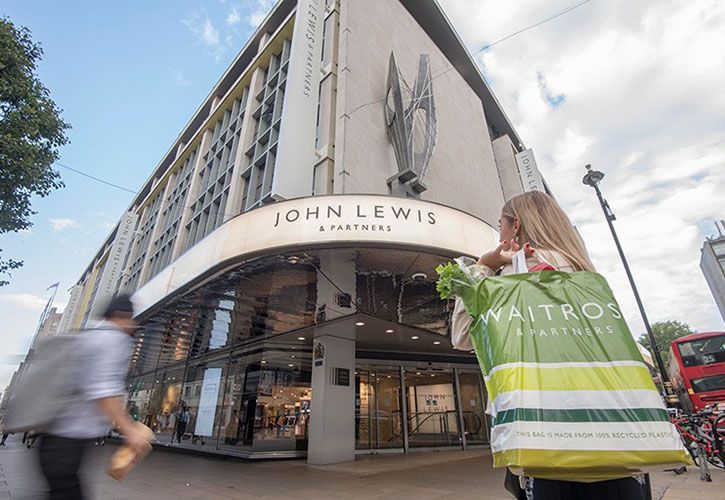UK DIY News
John Lewis Partnership Makes First Half Loss; Cancels Bonus

The John Lewis Partnerhsip has announced half year results, covering the six months to the 25th July.
Excerpts from the letter sent from Chairman Sharon White to Partners follow:
As a Partnership, we have the great advantage that we are able to take a long-term view. We can take the right decisions for the long-term benefit of our customers and our Partners; we can be bolder and more innovative than conventional companies, even in these challenging times.
Constitutionally, we are required to make ‘sufficient’ not ‘maximum’ profit to invest back into the business and in our Partners. We are driven to make a difference to people’s lives and create positive social change. In that sense, we are a social enterprise.
The pandemic has brought forward changes in consumer shopping habits which might have taken five years into five months. Both brands entered the crisis with strong and established online businesses and in the case of Waitrose, plans for expansion well underway in preparation for the end of the relationship with Ocado. Our digital businesses, powered by Partners, have been key to underpinning our first half performance.
In the first six months of this year, the Partnership made a loss of £(55)m, about the same as this time last year, a creditable performance in the circumstances and ahead of expectations in our April trading update. Sales were a touch higher than last year - up 1%. But shoppers spent more on less profitable lines such as laptops and loo rolls. We benefited from Government support through the furlough scheme, which we exited at the end of July, and business rates, which helped to offset £50m of additional pandemic-related costs like safety equipment.
Our cash and bank facilities position - the money we have to pay our bills - is strong. At the half year, we had £2.1bn compared to £1.5bn at the start of the crisis, mainly as a result of new borrowings.
We are expecting our debt ratio - our total net debts as a proportion of our cash flow - to worsen from 3.9 times - the position in January this year. We expect it to return to under 4 times in two to three years and we continue to target a level of around 3 times in the medium term.
In John Lewis, online sales growth was strong at 73%, helping to offset the impact of shop closures, with overall sales down (10)% on last year. Sales momentum is starting to build in reopened stores, with sales down around 30% on last year, ahead of expectations. Stores in retail parks are down by around 15% and are doing better than city centres, especially London which is down around 40%. Home working has had a big impact on what people are buying - more TVs and tablets, fewer trousers and trainers. Online now accounts for more than 60% of sales, from 40% before the pandemic. As a result of this pronounced shift to digital we had to reassess how much shops contribute to whether our customers buy online with us or not. Before the crisis we believed that shops contributed around £6 of every £10 spent online. We now think that figure is, on average, around £3. This has the effect of reducing the book value of John Lewis shops by about £470m, known as an ‘impairment’. This is a technical adjustment in our accounts and has no impact on our underlying profits or cash in the bank. There is some judgement here. If shops drove 10% more online sales in future, the impairment would be around £400m; 10% less and it would be around £570m.
In Waitrose, like-for-like sales were up almost 10% on last year. The early days of stockpiling pasta and long life milk have given way to a varied basket with more fresh produce and a return to the weekly shop. Demand for online shopping remains strong and we are now delivering around 170,000 weekly orders, up from around 60,000 before the pandemic. The average basket size is four times bigger for home deliveries than in store.
LOOKING AHEAD TO THE SECOND HALF OF THE YEAR
Early weeks of trading have been encouraging in both brands. In John Lewis our new Home collection has launched and a bigger revamp for this key category is set for next spring. Services previously only available in store - personal and home styling, beauty and nursery advice - can now be accessed online as well and take-up is high.
Waitrose has seen a strong pick-up in demand since the end of our relationship with Ocado on 1 September. Waitrose.com orders were up 9% in the first week. Waitrose.com is now a £1bn annualised business and we will further expand capacity by around 50% to 250,000 orders a week. We have also entered into a trial partnership with Deliveroo, which has seen very positive early results. Up to 500,000 customers in five areas can now get 30 minute deliveries, with plans to add 25 more localities.
The outlook for the second half is clearly uncertain given the broader macroeconomy. Christmas trade is also particularly important to profits in John Lewis and I would ask Partners to do everything we can to serve customers brilliantly both in John Lewis and Waitrose. In April, we set out a worst case scenario for the full year of a sales fall of 5% in Waitrose and 35% in John Lewis. That remains our worst case view. We now believe the most likely outcome will be a small loss or a small profit for the year. As I have mentioned previously, we are targeting £100m head office savings, and we are aiming to make these savings as early as possible this financial year and next.
IMPLICATIONS FOR BONUS
I said to Partners in April that I could not see the circumstances in which we would be able to pay a bonus next March. The Partnership Board has now confirmed that there will not be a bonus next year given our profit outlook. I know this will come as a blow to Partners who have worked so hard this year. The decision in no way detracts from the commitment and dedication that you have shown. Outside of exceptional circumstances, we would now expect to begin paying a bonus again once our profits exceed £150m and our debt ratio falls below 4 times. Once our profits rise above £300m and a debt ratio below 3 times, we would expect to pay a bonus of at least 10%. The Partnership found itself in a similar position in 1948 when the bonus was halted following the Second World War. We came through then to be even stronger than before and we will do so again.
Source : John Lewis Partnership
I find the news and articles they publish really useful and enjoy reading their views and commentary on the industry. It's the only source of quality, reliable information on our major customers and it's used regularly by myself and my team.











































